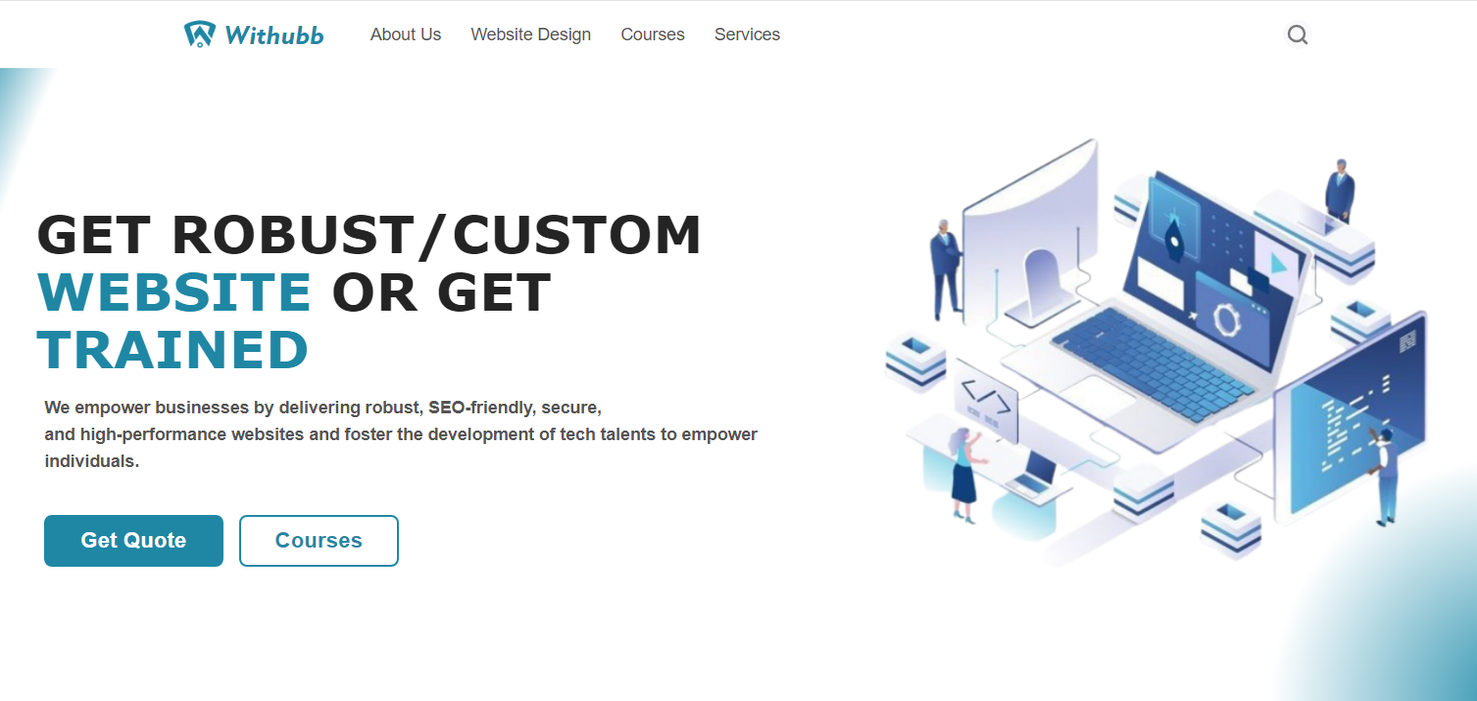Top 10 website development trends 2024

Imagine stepping into a world where websites know exactly what you want, load instantly, and look stunning on any device you use. As we move through 2024, web development trends are taking bold strides forward, reshaping how we interact online. From AI-driven experiences to sleek, dark-mode designs, these innovations aren’t just trends—they’re shaping the future of digital experiences. In this article, we’ll dive into the top ten website development trends you simply can’t ignore this year.
1. Artificial Intelligence and Machine Learning
One of the most significant advantages of AI in web development is its ability to automate repetitive tasks and processes. By incorporating AI-powered chatbots for customer support or implementing predictive analytics for content recommendations, developers can streamline operations and enhance user satisfaction. With AI at the helm, websites can deliver personalized experiences, respond to user queries promptly, and adapt to changing trends seamlessly. The future of web development is undoubtedly intertwined with the intelligent automation that AI brings to the table.
These intelligent chatbots leverage artificial intelligence and machine learning algorithms to provide instant responses to user queries, enhancing the overall user experience. Through personalized interactions and quick response times, AI chatbots streamline customer support processes and boost user satisfaction.
Natural language processing technology allows AI chatbots to communicate in a conversational manner.
Machine learning algorithms enable chatbots to learn and improve their responses over time.
AI chatbots offer 24/7 support, reducing the need for human intervention and increasing efficiency in handling user queries.
As businesses strive to provide seamless and efficient customer service, AI chatbots are poised to play a pivotal role in enhancing user engagement and driving conversion rates. By integrating AI chatbots into websites, businesses can offer personalized support, improve response times, and ultimately, create a more satisfying user experience.
2. Progressive Web Apps (PWAs)
These innovative apps offer the best of both worlds by combining the seamless functionality of native mobile apps with the accessibility of web browsers. Say goodbye to slow loading times and hello to instant gratification as PWAs provide lightning-fast loading speeds, making them a top choice for users who value efficiency and convenience.
PWAs are designed to enhance user engagement through intuitive interfaces, smooth transitions, and responsive design. By incorporating features like offline access and push notifications, PWAs allow users to stay connected when they are offline, even in low connectivity scenarios. With PWAs, users can enjoy quick access to content, even in areas with poor internet connectivity. Say goodbye to frustrating loading screens and hello to smooth transitions between pages, creating a seamless and enjoyable browsing experience for all.
PWAs work across devices and operating systems, ensuring a cohesive experience regardless of platform. Developed with core technologies like HTML, CSS, and JavaScript, PWAs are lightweight and easier to maintain than native applications. By eliminating the need to download apps, they provide faster access and are particularly appealing for users who value simplicity and efficiency.
3. Voice Search Optimization
With the increasing prevalence of voice recognition devices like smart speakers and virtual assistants, optimizing for voice search is not just a trend but a necessity. Websites that are voice search-friendly provide a seamless and efficient user experience, catering to the growing number of users who rely on voice commands to access information. By understanding user intent and crafting content that matches natural language queries, developers can create a more user-centric and engaging website experience.
As mobile devices continue to dominate internet usage, optimizing for voice search is essential for reaching mobile users effectively. Voice search is often used on-the-go, making it a convenient and hands-free way for users to find information quickly. By prioritizing voice search optimization, web developers can ensure that their websites are accessible and user-friendly across all devices, catering to the needs of the modern mobile user.
With the rise of voice assistants like Siri and Alexa, users are increasingly relying on voice commands to search for information online. To ensure your website remains visible in voice search results, incorporating these optimization strategies is crucial:
Long-tail Keywords: Optimize your content with long-tail keywords that mimic natural language queries users may speak.
Direct Question Answers: Structure your content to directly answer common questions users might ask through voice search.
Structured Data: Implement structured data on your website to provide search engines with context and improve your chances of appearing in featured snippets.
As technology advances, so do user expectations. Optimizing for voice search not only improves website visibility but also demonstrates a commitment to staying ahead of the curve in web development. By embracing voice search optimization, developers can showcase their adaptability and willingness to embrace emerging trends, setting their websites apart from the competition and positioning them for success.
4. Motion UI
Motion UI is all about using subtle movements and animations to bring websites to life, making the browsing experience more intuitive and enjoyable. Whether it's a smooth transition between pages or a subtle hover effect on a button, Motion UI adds a layer of sophistication and creativity to web design. As web developers seek to create immersive and engaging experiences for users, Motion UI is becoming an essential tool in their arsenal.
Developers can leverage motion UI libraries and frameworks to easily integrate animations and transitions into their websites. These tools provide a wide range of pre-built animation effects that can be customized to suit the website's design and branding. With the right use of motion UI and web animations, developers can create a visually stunning website that not only looks great but also functions seamlessly for users.
Motion UI is a trend that is here to stay, offering web developers a powerful tool to create visually appealing and engaging websites. By embracing motion and animation in their designs, developers can enhance user experience, improve engagement, and set their websites apart in a crowded online space. As we look ahead to 2024, Motion UI will continue to drive innovation and creativity in web development, shaping the future of digital experiences for years to come.
5. Serverless Architecture
Say goodbye to traditional server management headaches and hello to a streamlined, cost-effective solution that empowers developers to focus solely on writing code. By utilizing cloud-based services like AWS Lambda and Google Cloud Functions, businesses can scale their web development efforts without the worry of server infrastructure.
By eliminating the need for server management, developers can focus on coding and innovation. This approach allows functions to run in the cloud, triggered by specific events, resulting in improved scalability and reduced infrastructure costs. The flexibility of serverless architecture enables websites to handle traffic spikes efficiently and allocate resources effectively.
Implementing serverless architecture in website development offers numerous benefits. Developers can deploy functions quickly and efficiently without the overhead of server maintenance. This approach streamlines the development process, allowing for faster iterations and updates. Additionally, serverless architecture enables better cost management, as resources are utilized only when needed, optimizing performance and scalability.
6. Responsive Web Design
With the increasing use of mobile devices for internet browsing, it's essential to ensure that websites are accessible and user-friendly across various platforms. Responsive design allows websites to adapt seamlessly to different screen sizes, providing a consistent user experience regardless of the device being used. By prioritizing responsive site design, web developers can cater to the needs of a diverse audience and enhance user engagement.
Ensuring that websites are responsive and easily navigable on mobile devices is key to retaining user interest and promoting a positive user experience. By incorporating responsive design principles, websites can maintain their functionality and aesthetic appeal across a range of devices, from smartphones to tablets to desktop computers. This adaptability is crucial for meeting the evolving expectations of modern internet users.
7. Dark Mode Standardization
One trend stands out as a game-changer: Dark Mode Standardization. With more and more users embracing dark mode for its sleek look and reduced eye strain, websites are adapting to meet this demand. By incorporating dark mode as a standard feature, websites can enhance user experience and cater to the preferences of a modern audience.
Dark mode has become a ubiquitous feature across various platforms, offering users a sleek and modern browsing experience. Its popularity stems from its ability to reduce eye strain, enhance readability in low-light environments, and even conserve battery life on certain devices. In recent times and beyond, dark mode standardization is expected to take center stage in website development, ensuring a consistent and visually appealing user experience.
Leveraging Dark Mode
Aesthetic Appeal
Dark mode's aesthetic appeal has captivated users worldwide, providing a stylish alternative to traditional light themes. Its sleek design and minimalistic approach make browsing more comfortable and visually appealing, especially during nighttime or in dimly lit surroundings.
User Preference
With the rising demand for customizable features, users appreciate the option to switch between light and dark modes seamlessly. Standardizing dark mode across websites allows for a unified user experience, catering to diverse preferences and enhancing overall accessibility.
Energy Efficiency
Dark mode not only offers a stylish appearance but also contributes to energy efficiency, particularly on devices with OLED screens. By displaying darker colors, dark mode reduces energy consumption, prolonging battery life and aligning with eco-friendly practices.
As website developers embrace dark mode standardization, they are not only meeting user expectations but also staying ahead of design trends. Incorporating dark mode options into websites showcases a commitment to providing a user-centric experience and enhancing accessibility for all visitors. Dark mode standardization is not just a trend but a necessity for websites looking to stand out and engage users effectively.
8. Low-code and No-code Development
Gone are the days of complex coding languages and intricate scripts. Low-code and no-code development platforms are revolutionizing the way websites are created, allowing individuals with minimal coding knowledge to build functional and visually appealing websites. These platforms offer intuitive drag-and-drop interfaces that streamline the development process, enabling users to bring their ideas to life with ease. Say goodbye to long hours spent deciphering lines of code – with low-code and no-code tools, web development has never been more accessible.
low-code and no-code development platforms empower non-developers to take control of their online presence. Whether you're a small business owner looking to establish a professional website or an aspiring blogger wanting to showcase your content, these platforms provide the tools needed to create a unique and engaging web presence. Say hello to creative freedom and limitless possibilities – with low-code and no-code development, anyone can become a web developer.
Low-code and no-code platforms offer a quicker route to launching websites, reducing development time and accelerating time to market. By eliminating the need for extensive coding and programming, these platforms enable users to create and deploy websites in a fraction of the time it would traditionally take. See your ideas come to life at lightning speed – with low-code and no-code development, the possibilities are endless.
9. Cybersecurity Enhancements
Cybersecurity is more critical than ever for websites to protect user data and prevent cyber threats. Implementing robust security protocols, such as multi-factor authentication and encryption standards, is essential to safeguarding sensitive information. Regular security audits and vulnerability assessments help identify and address potential risks, ensuring the integrity of websites and maintaining user trust.
As cyber threats continue to evolve and become more sophisticated, staying ahead of potential security breaches is a top priority for web developers. By incorporating cybersecurity enhancements into website development, businesses can create a secure online environment for users to interact with confidence. Encryption plays a vital role in securing data transmission and storage, safeguarding sensitive information from unauthorized access and cyber attacks.
Cybersecurity is not just a one-time consideration; it requires ongoing vigilance and proactive measures to protect websites from ever-evolving threats. By prioritizing cybersecurity enhancements, websites can build a strong defense against malicious actors and mitigate risks effectively. User trust and data integrity are paramount, making cybersecurity a crucial aspect of website development in 2024 and beyond.
As technology continues to advance, the need for robust cybersecurity measures will only grow, making it imperative for websites to stay updated with the latest security protocols and practices. Enhancing cybersecurity in website development goes beyond compliance; it is a proactive approach to safeguarding user data and maintaining the integrity of online platforms. By investing in cybersecurity enhancements, websites can build a secure digital ecosystem that prioritizes user privacy and protection.
10. Internet of Things (IoT)
The Internet of Things (IoT) is not just a buzzword; it's a game-changer in website development. By connecting various devices and enabling seamless communication between them, IoT integration opens up new opportunities for creating innovative and interconnected experiences. Imagine a website that can interact with your smart devices, collect data, and provide customized services based on your preferences. The possibilities are endless and in modern times alot of positive changes have been made.
One of the key benefits of IoT-enabled websites is the ability to provide personalized experiences to users. Imagine a website that adjusts the lighting and temperature settings in your smart home based on your preferences or monitors your health data from wearables. By leveraging IoT technology, websites can offer customized services that cater to individual needs and preferences, ultimately enhancing user experiences and increasing engagement.
IoT has made impacts in revolutionizing industries. By enabling seamless communication between devices, IoT integration in web development is transforming the way businesses operate. From optimizing supply chains to enhancing customer experiences, IoT-enabled websites are reshaping industries and driving innovation.
Final Thoughts
Website development trends will continue to evolve, driven by technological advancements and user expectations. Each of these trends offers unique opportunities to elevate user engagement, streamline processes, and enhance functionality. From AI and IoT to cybersecurity and dark mode, these trends highlight a commitment to user-centric design, efficiency, and security.
Embracing these developments enables businesses and developers alike to remain competitive and relevant in a digital-first world. As we look toward the future, the key to successful web development lies in blending innovation with adaptability, creating websites that not only meet today’s demands but are prepared for tomorrow’s possibilities. The websites that embrace these trends will not only stand out in crowded online spaces but also set new standards for functionality, design, and user experience.
More Articles

SQL Queries: A comprehensive guide for beginners
1 week, 3 days ago · 9 min read
What is Withubb Ltd? ( Withubb web and IT services, features and benefits)
1 week, 5 days ago · 8 min read
How to Set Up Django with PostgreSQL, Nginx, and Gunicorn on Ubuntu VPS Server
2 weeks, 5 days ago · 11 min read
Landing Page Best Practices for High Conversion Rates
1 month ago · 8 min read
.org, .com and .net Choosing the right domain extensions
1 month ago · 6 min read
Skills to Become a Full Stack Developer in 2025
1 month, 1 week ago · 11 min read
How to Choose the right Database for Your Business Website
1 month, 1 week ago · 6 min read
Avoiding common programming mistakes: best practices for quality code
1 month, 2 weeks ago · 16 min read
What is Domain parking and how to earn money from it ?
1 month, 2 weeks ago · 8 min read
Steps to Building an SEO-Friendly Website
1 month, 3 weeks ago · 7 min read
x

